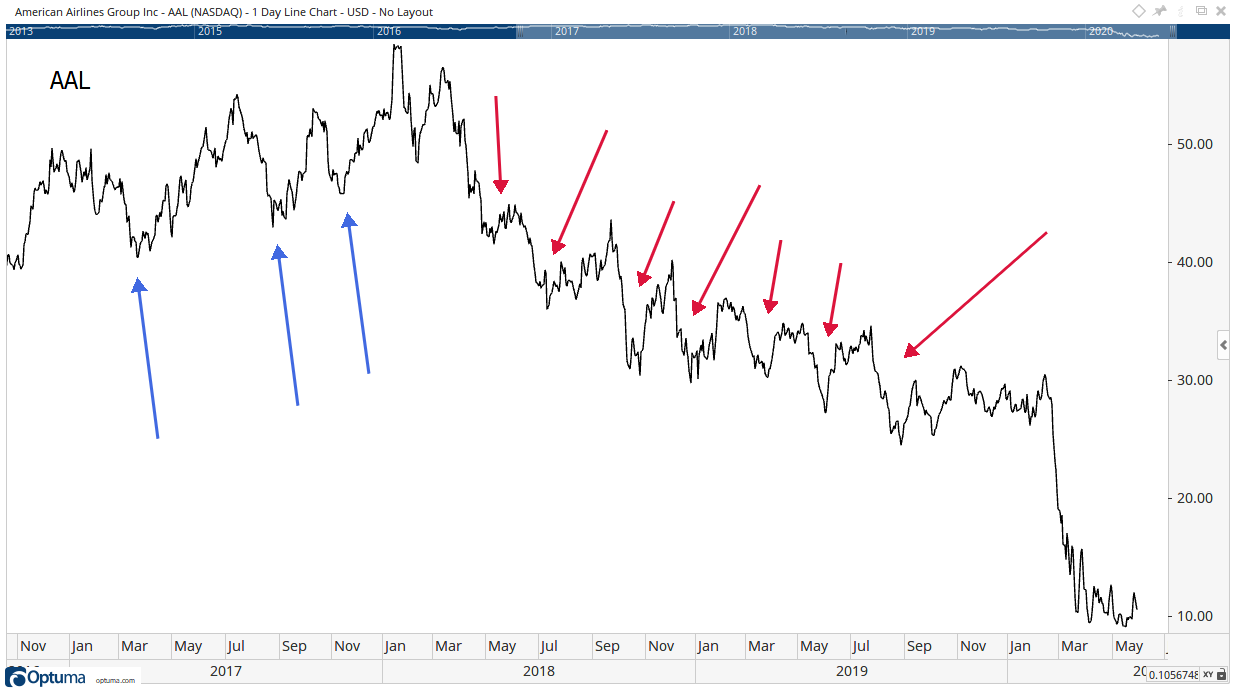One of the most popular investment strategies is to buy the dip. It means buy more stocks as prices fall. In a bull market, it works. But, if we’re being honest, buying anytime works in a bull market.
The chart below shows that buying the dip doesn’t always work. This is a chart of American Airlines Group (Nasdaq: AAL). The stock has been in a downtrend since the beginning of 2018 and buying dips led to increased losses.

Source: Optuma
This is anecdotal evidence that buying the dip doesn’t work. Of course, I could also show anecdotal evidence demonstrating the strategy does work.
To Buy the Dip, or Not to Buy
Instead of presenting dueling charts, let’s review actual data. This is an idea that can be tested.
For the test, I’ll define a dip as a new 20-day low. For comparison, I’ll also test buying new 20-day highs. For both tests, I’ll hold for one month. The test will look at all the stocks in the S&P 500 over the past 20 years. That time captures two bear markets, two bull markets and the recent gyrations in the stock market.
This test basically compares buying dips to buying new highs. The results are shown below.
| % Wins | Average Gain | |
| Buy the dip | 58.0% | 1.4% |
| Buy the breakout | 57.5% | 1.0% |
As the test shows, buying the dip is a good strategy. It beats buying breakouts.
This might be a surprise, but both strategies beat the market. Whether you bought dips or breakouts, the strategy delivered an average annual gain of more than 7%. Index investors achieved annual returns averaging about 6%.
Perhaps more importantly, both strategies had less risk than buy and hold.
The test period included two bear markets. Investors who bought in early 2000 didn’t break even until 2013. With either buying the dip or buying the breakout strategies, losses were always recovered in one year.
Both strategies beat the market and reduced risk by having an exit strategy. Both tests required an exit after four weeks. This means your money is only at risk a short amount of time.
Exit rules can dramatically improve performance. They avoid large losses. That’s important because losses can be life changing.
Imagine someone who planned to retire in 2000 or 2008. Bear market losses could result in delaying retirement by years. A bear market could mean missing time with grandchildren or working until health problems make retirement less enjoyable.
That’s the real risk buy-and-hold investors face. Traders with an exit strategy can enjoy a higher likelihood of having the money they need when they need it.
A note from author Michael Carr: Soon, I’ll be sharing details on a strategy I’ve been trading for a local animal rescue. It’s a short-term strategy. On average, trades are closed about two days after they’re opened. I placed $10,000 in that account on Jan. 1 and we made more than $7,600 in gains by May 31. To learn more, click here.
• Michael Carr is a Chartered Market Technician for Banyan Hill Publishing and the Editor of One Trade, Peak Velocity Trader and Precision Profits. He teaches technical analysis and quantitative technical analysis at New York Institute of Finance. Mr. Carr also is the former editor of the CMT Association newsletter Technically Speaking.
Follow him on Twitter @MichaelCarrGuru.




